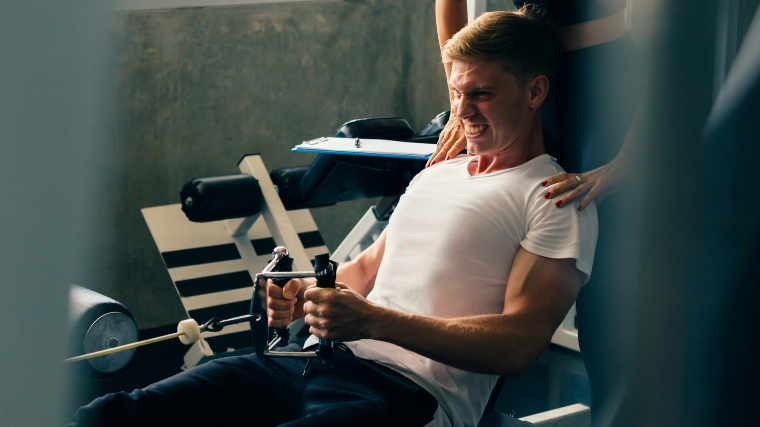Your back offers such a huge amount of real estate to play with — add cable machines to the mix and you’re in for a grand old time.
No two bodies are alike, and this individuality between you and your gym partner is exactly what makes some implements more enjoyable than others. The cable machines found in most commercial gyms are uniquely beneficial for almost everyone, though, and will give you an increased ability to really carve out the perfect back workout — and the perfect back along with it.

Regardless of your experience level, a good cable stack machine can be all you need to isolate and stimulate your back. Here’s how.
Best Cable Back Workouts
- Cable Back Workout for Beginners
- Cable Back Workout for Intermediates
- Cable Back Workout for Advanced Lifters
Editor’s Note: The content on BarBend is meant to be informative in nature, but it should not be taken as medical advice. When starting a new training regimen and/or diet, it is always a good idea to consult with a trusted medical professional. We are not a medical resource. The opinions and articles on this site are not intended for use as diagnosis, prevention, and/or treatment of health problems. They are not substitutes for consulting a qualified medical professional.
Best Cable Back Workout for Beginners
Your back offers a ton of potential options to design your workout around. When attacking your training as a beginner, a combination of exercises that help to build your overall strength, stability, and muscle mass simultaneously is a wise approach.
A smart selection of cable exercises will allow you to lean into all of these attributes in your early programs to see huge progress across the board.
The Workout
Choose a solid single-arm exercise to help with stability and coordination (particularly if you have to stabilize the position without a machine). Add in a few easier bilateral (both arms at the same time) exercises that you can load heavier for some strength and you’ll be well on your way.
You may also want to finish off your workout with a few exercises that leave you with a gnarly pump and will help build some muscle. This isn’t mandatory, but it’s a good way to cover your bases early on.
- Half-Kneeling Single-Arm Cable Pulldown: 3 x 12-15 per arm
- Close-Grip Cable Pulldown: 3 x 10-12
- Seated Cable Row: 2 x 10-12
- Cable Reverse Fly: 2 x 15
Best Cable Back Workout for Intermediates
Once you’ve built a sturdy foundation as a beginner, your intermediate workout should help refine the back-specialized training to target each side of your body a bit more individually.
Unilateral exercises are great at ensuring that each muscle group gets a solid stimulus without the opposite side compensating, so you’ll dive into a lot of single-arm work.
You can also choose to adjust your grip position, or specify between row and fly styles of exercise execution, to add more load (and challenge) throughout your workout.
The Workout
Grip style and exercise execution will help you load up a bit more weight on the working muscles while also isolating the smaller muscle groups to a greater extent.
An underhand grip lat pulldown makes for a great choice here — cutting out some of the other muscle groups from the pulldown and allows you to really lean into blasting your lats with direct mechanical tension.
- Seated Underhand Single-Arm Lat Pulldown: 3 x 10-12 reps per arm
- Seated Single-Arm Cable Row: 3 x 10-12 reps per arm
- Wide-Grip Cable Pulldown: 3 x 12-15
- Seated Rear-Delt Cable Row: 3 x 10-12
Best Cable Back Workout for Advanced Lifters
Diversification of your exercise selection is a key factor in long term progress for advanced lifters . Many of your back muscles act synergistically, meaning that they will contribute in various ways to each exercise throughout your workout, even if they aren’t the star of the show.
Dividing your effort and attention across a wide array of movements can help extend your ability to train hard in the gym.
The Workout
A half-kneeling, single-arm pulldown is a great example of an exercise that is extremely beneficial as a beginner and to gymgoers with years of battle-hardened experience under their belts.
Use it to maintain an ability to stabilize and perform full range of motion exercises intact. Afterward, kick up your volume and hit a wide assortment of different movements to ensure your back is torched from top to bottom.
Take all sets close to failure and you’ll see monster gains, even after years in the weight room.
- Half-Kneeling Single-Arm Cable Pulldown: 2 x 10-12 reps per arm
- Seated Underhand Single-Arm Lat Pulldown: 2 x 10-12 reps per arm
- Single-Arm Cable Row: 3 x 10-12 reps per arm
- Wide-Grip Cable Row: 2 x 10-12
- Rear-Delt Cable Row: 2 x 10-12
- Wide Grip Cable Pulldown: 3 x 12-15
How To Progress With Cable Workouts
On your journey to build an enormous back, you might find yourself working your way between beginner, intermediate, and advanced levels of competence.
There are several quick tips and tricks to spice up the workouts you’re currently on as you continue to make gains.
Progressing your cable back programming can come down to the degree of isolation you approach your workouts with, making sure you’re using both bilateral and unilateral exercises, and the strategic implementation of volume.
Isolate Your Tissues
Most back day movements will include more than one muscle group acting synergistically. While the latissimus dorsi may be the major contributor to a pulldown exercise, for instance, there are others at play helping out like the traps and rhomboids.

Narrowing your focus as you become more experienced can help drive progress long-term. Consider splitting your workout a bit more specifically into movements that better bias certain areas (such as the traps, rhomboids, or lats).
Go Unilateral
Along the same lines as the degree of isolation you employ during your workouts. Many beginner workouts tend to have you emphasize bilateral exercises that develop large amounts of muscle and stability, rather than single-joint or unilateral movements.
This can also be an avenue of progression — making the leap from a bilateral pulldown, for example, to the unilateral version.
Up the Volume
While volume isn’t the be-all-end-all of progression, it is a sure-fire way to see more gains. Early on while you’re still building a foundation or making a transition between workouts, prioritize good form and good habits.
Afterward, though, building up your training volume through more sets or repetitions per exercise is a good way to assure you’re moving smoothly along the proverbial highway from beginner to intermediate (and beyond).
Use Intensification Techniques
The workouts listed above are pretty straightforward, but you can definitely add a pinch (or pile) of seasoning to make them more difficult.

One of the biggest perks of working with cables is the external stability and safety the machine provides. You’re not likely to have an accident if you push yourself to or past failure, so cable-based movements are a safe and secure way to take things to the limit.
Try plugging in some drop sets, rest-pause work, or other forms of high-intensity training techniques to drive progress.
Anatomy of the Back
The back is a huge, huge swath of muscle that is actually the combination of many smaller ones. The trapezius, latissimus dorsi, rhomboids, rear-delts, and teres group are all common muscles that find their way into back training sessions.
Trapezius
The trapezius (or traps) are a large diamond-shaped muscle which spans from the mid-back, between your shoulder blades, and up to alongside your neck.
Your traps have an assistive role in a variety of exercises, but in particular will contribute to movements that retract and elevate your scapula.
When performing exercises, a more neutral grip where the elbows flare wider during the pull is a great way to engage the traps.
Latissimus Dorsi
The latissimus dorsi is one of the largest muscle groups of the body. It originates on your thoracolumbar fascia and has a broad array of insertion points across your arm, upper back, and shoulder.

Your lats are responsible for a ton of force production during various pulling exercises, particularly those that keep the arm in a more tucked position. A neutral or underhand grip on these exercises will also help target your lats more effectively.
Rhomboids
The rhomboids are a smaller muscle group than the traps, but perform a similar task during most loaded pulling exercises. They also sit deeper on your body, beneath your middle trapezius, and are thus hard to see visually, even when developed well.
They are attached to the scapula and various points of your spinous processes, meaning they are excellent at squeezing your shoulder blades together.
Similar movements that target your traps will help stimulate the rhomboids.
Rear Delts
While the rear-delts are technically part of the shoulders, you can consider anything on the backside of your body as fair game on back day.
To better target your rear delts, perform rows or fly exercises with a slightly-below-parallel arm position. If your arms were extended straight out from your body like a “T”, drop the arm position by a few inches to align the exercise with your rear delts.
Teres Minor
The teres minor is often the unsung hero of back day. It is located towards the top of the upper arm and attaches near the base of your shoulder blade, helping with the initiation of many pulldown exercises.
This tiny tissue contributes to the appearance of a textured, mountainous upper back, but also serves to stabilize the scapula during overhead movements.
You can place a bit more focus on the teres minor by utilizing a wider grip, helping to build out the aesthetic of the upper corners of your back.
Benefits of Cable Workouts
Cable-based exercises are some of the most diverse and universally-beneficial tools for your body and workout programming.
They are extremely customizable to your unique anatomy and proportions, can be used in both unilateral and bilateral training, and offer a high amount of external stability if needed.
They’re Highly Customizable
You, like most lifters, will have an extremely unique structure. The broadness of your shoulders, length of your arms, and even your torso size make certain exercises harder or easier to effectively execute.

A cable system is so widely variable that it can accommodate nearly every single person and their goals, allowing you to adjust various settings to line up the resistance just right for your dimensions or needs.
You Can Work Unilaterally and Bilaterally
Building a strong (and aesthetic) back will usually demand that you work both unilaterally and bilaterally.
Bilateral exercises (using both sides of the body at the same time) are great for adding more load and are usually more stable. Conversely, unilateral exercises help you carve out the finer details of your physique and avoid muscular imbalances.
Cable systems with their various grip selections are fantastic at covering all bases here, offering a huge selection of exercises and modifications to suit your needs.
Provides Added Stability
A cable stack is the perfect middle ground between absolutely stabilized (like on a machine) and completely unstable (such as a free weight).
The semi-stabilized nature of a cable system allows you to move freely through any range necessary to stimulate muscle, but will also challenge you to control the implement or handle you’re working with.
Most cable stations are large and allow you to brace your body as much as you need, letting you accommodate your stability in real time.
Grip and Rip
It may seem silly to base an entire workout around one piece of equipment, but cable-based back training can breathe a lot of life into your routine.
With a plethora of muscle groups, exercises, grip selections, even training splits to define and redefine your back training, a cable-only workout might just be the perfect fit to help you get more fit.
There’s no reason to limit your gains to dumbbells or machines that may not be the best for your body structure. Lean into the massive customizability of cable-based workouts to accommodate your unique size and shape. They’re perfect for beginners, advanced lifters, or anyone in-between.
Featured Image: Goami / Shutterstock